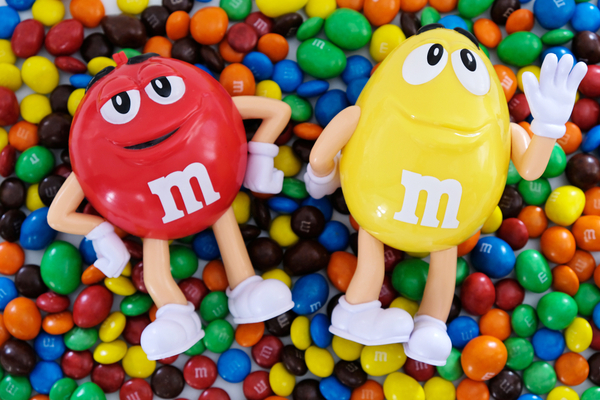Kids love ’em, adults feel nostalgic eating them, and they won’t melt in your hand, just in your mouth — we’re talking M&M’s here. It’s National M&M Day, so get ready to celebrate. Created in 1941, this iconic candy has been a staple for over 75 years.
The idea for M&M’s came to be when Forrest Mars Sr., son of the original Mars Company founder Frank Mars, saw people in Great Britain carrying around (and eating) Smarties, which were chocolate pellets protected by a hard candy shell to keep them from melting. So, M&M’s weren’t an original idea? Nope. They were made by Rowntree and they were called Smarties. In fact, it’s said that Mars was a good friend of Rowntree founder George Harris.
To make his idea of a candy that “melts in your mouth but not in your hands” a reality, Forrest Mars went against his own principle of business success: He enlisted the aid of a competitor. He decided to go to, believe it or not, Hershey, to ask for backing. He went to the office of William Murrie, who had taken over the day-to-day operations of the company from Milton Hershey. It took a bit of audacity, but Forrest came and pitched the idea of making these small candies that melt in your mouth but not in your hand. Some sources attest that he had some Rowntree Smarties with him at the time, and that he claimed to hold the foreign production rights for them. Any connection between Smarties and M&M’s is vehemently denied by the present day Mars company, but it’s hard not to make the comparison.
Why didn’t Forrest just go to his father’s candy company to launch his idea? Theirs was a bitter, estranged relationship, and the two weren’t even on speaking terms at the time of Frank Mars’ death in 1934. So, Forrest needed Hershey to produce the chocolate for the candy. He proposed, as well, that he should enter into partnership with Murrie’s son, Bruce, with whom Forrest was already associated. He offered to share top-billing with Bruce. William Murrie agreed and there we have the origin of the name of M&M’s. The first “M” stands for Mars, and the second “M” stands for Murrie, meaning Bruce Murrie. The two called the new company, which began operation in 1940, M&M Ltd..
Hershey contributed the chocolate, 20% of the capital, and manufacturing equipment as well as engineers to help get the plant ready. After the plant began operations, Forrest paid no attention to Murrie, ignoring all his ideas, until, in 1949, Mars bought him out for $1 million. It was then that the famous slogan, “melts in your mouth, not in your hands” was born. After splitting from Murrie, Mars changed the name of the company to Food Manufacturers, Inc.. By that time, M&M’s were a huge success, with $3 million in annual sales. When Frank’s widow passed away in 1945, half of the Mars Company stock went to Forrest, and after several years of some boardroom wrangling, Forrest Mars Sr. finally ended up Chairman of his late father’s company in 1959, and in 1964, he merged it with his own Food Manufacturers, Inc. to come full circle at last, as the new and improved Mars Inc. became the manufacturer of our beloved M&M’s.
Did you know?
- A black “M” was originally printed onto M&M’s in 1950 to give them a unique look — it was changed to a white “M” in 1954.
- 1954 was the same year when Mars decided to add a Peanut into the mix and created Peanut M&M’s.
- Because of how easy they are to eat, M&M’s are a favorite of Astronauts, and the most consumed chocolate in outer space.
- Today, we associate a tube of M&M’s with mini M&M’s, but back in the day, the original packaging of all M&M’s was actually a cardboard tube.
- Some old-schoolers may recall when there was both a brown AND tan M&M. Mars eventually decided that having tan and brown M&M’s was silly — and that tan candy was a bit underwhelming — so they had fans choose between blue, pink or purple as the color to replace tan M&M’s; obviously, blue was the winner.
- The company stopped making red M&M’s for 10 years because researchers linked the red dye amaranth to cancer (even though red M&M’s didn’t — and still don’t — contain this type of red dye); they picked orange as the replacement.
- Speaking of M&M colors, the green ones have long been the subject of myth as they are considered, by some, to have magical aphrodisiac powers. … The myth about Green M&M’s was fueled in the late seventies and early eighties, as rock-and-roll performers like Van Halen requested bowls of Green M&M’s backstage.
—
Photo Credit: BORIMAT PRAOKAEW / Shutterstock.com
